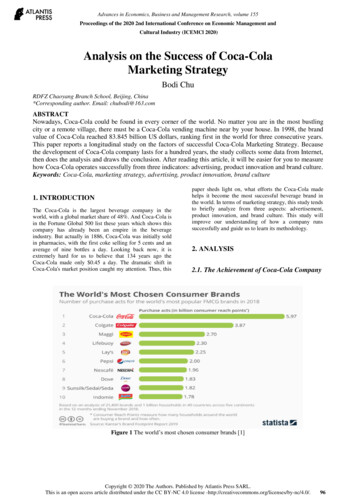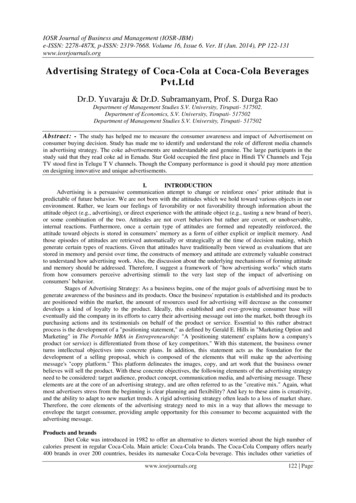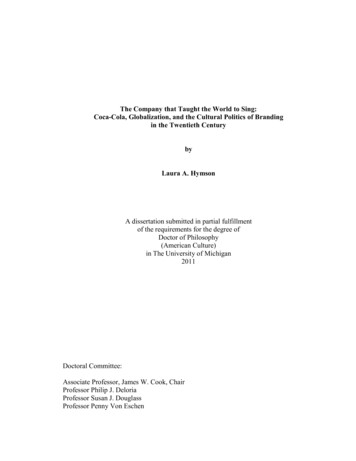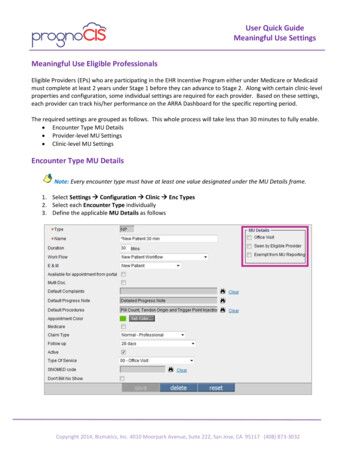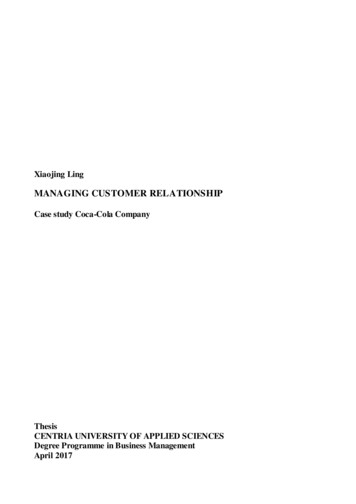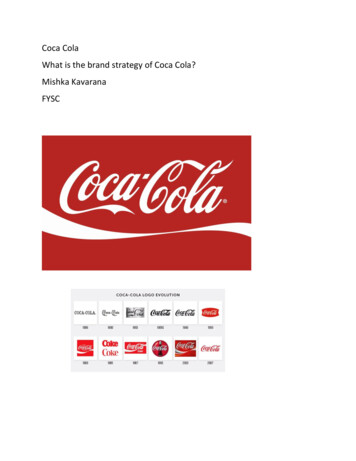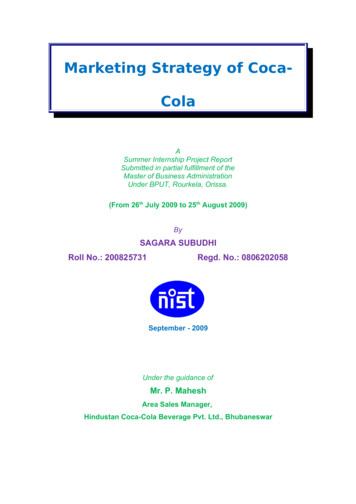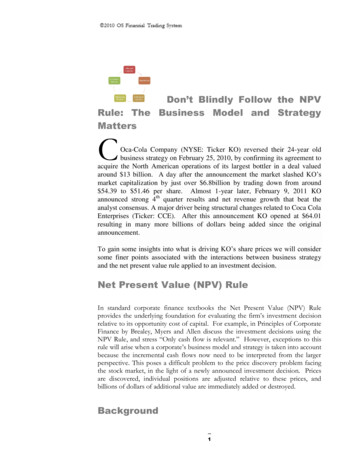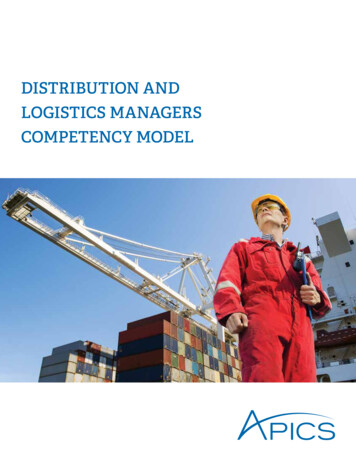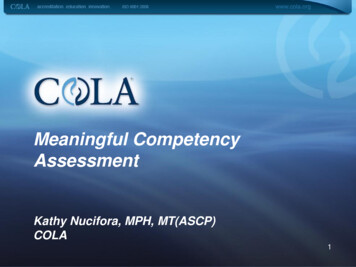
Transcription
Meaningful CompetencyAssessmentKathy Nucifora, MPH, MT(ASCP)COLA1
Objectives Differentiate between Competency Assessment andthe traditional performance evaluation Outline the six CLIA-required components ofCompetency Assessment Apply methods described to conduct and documentmeaningful competency assessments Comply with COLA criteria that address CompetencyAssessments2
The problem with competencyassessment “It’s hard to see aproblem clearly if you’vealready decided what todo about it.” Levitt and Dubner3
4
We can easily definecompetency, but evaluatingcompetency in a meaningfulway can be challenging.5
Why the Emphasis on Competency? “Studies indicate that more education & trainingproduce higher quality results.” Judy Yost, “CLIACompliance, PT, and Quality Control: What’s New for 2012?” G2Webinar 2012 Competency confirms the effectiveness of training CLIA-defined Lab Director qualifications arestringent due to the overall responsibilities, buttesting personnel qualifications are minimal, basedupon complexity. Therefore, competence iscritical. Errors may have impact on patients.6
Assessing Competency vs.Performance EvaluationsTeam ome items that might be included on a personnel evaluation7
Direct Observation – routine patient testingDirect Observation – instrument maintenanceReview of Records - intermediate test recordsMonitor Result ReportingBlind Sample Testing - PT can satisfy this componentEvaluation of Problem Solving SkillsRequired for competency assessment for testing personnel8
Assessing Competency WHO is required to undergo competency assessment? Technical Consultant, Technical Supervisor Clinical Consultant General Supervisor Testing Personnel9
Assessing CompetencyThe Laboratory Director isnot required to havecompetency assessment –BUT is responsible for allCLIA defined responsibilities.10
Competency Evaluations WHO should evaluate competency? First it is important to have competent individualsassess the competency of the personnel under review.The reviewer should not be the Office Manager, theNursing Supervisor, or others who do not perform labtesting. CLIA gives this responsibility to the TC (moderatecomplexity) or TS (high complexity). Competency must be evaluated by qualifiedindividuals (TC/TS/GS).11
CLIA Requirements for PersonnelCompetency AssessmentSix required elements ofcompetency assessment12
Competency Evaluations Two of the six required assessment activitiesinvolve Direct Observation:1. Direct observation of routine patient testperformance; 2. Direct observation of performance ofinstrument maintenance and function checks;This can be documented with a detailedprocess oriented check list, per test orinstrument. 13
Competency Evaluations Two of the six required assessment activitiesinvolve Review of Records: 3. Monitoring the recording and reporting of testresults; 4. Review of intermediate test results, QC records,proficiency testing results, and preventivemaintenance records;Include with the competency documentation – recordsthat were reviewed.14
Competency Evaluations5. Assessment of test performance through testingpreviously analyzed specimens, internal blind testingsamples, or external proficiency testing samples;Rotate the performance of PT samples amongtesting personnel! 6. Assessment of problem-solving skills . Use problem logs, QC corrective action, complaintinvestigations, specimen rejection incidents 15
Competency Assessment Don’t waste paper Don’t waste time Make it meaningful!16
What does documentationof competency assessmentlook like?17
18
19
20
Patienttesting MaintenanceDirectobservationRecordreview Intermediaterecords Reporting Blind sampletesting ProblemsolvingAssesscompetency21
Competency assessment – Serum OsmolarityDirect observation – with DETAILS listing each critical stepInstrument maintenanceTest performanceReview of RecordsIntermediate records – attach copy of Osmoworksheet with controls recordedResult reporting – attach copy of final result withany result comments, critical values, etcBlind Sample analysisAttach copy of report and expected resultsProblem Solving“What if” scenariosAttach problem logs with resolution22
Competency assessment – Serum OsmolarityYour documentation should include: Notation of direct observations Includes each critical step in the test performance Copies of records reviewed Blind sample testing with results and acceptability Problem logs, quizzes, or “what would you do if”scenarios Conclusion – is the testing personnel competent toperform this test? Need for further training, if necessary Signature of testing personnel and person evaluating23competency
FAQ Do personnel performing PPM require competencyassessment? Who can evaluate competency? Do all elements of competency assessment need to bedone at once? Does PT satisfy competency assessmentrequirements? Profiles – can you do one competency assessment fora panel of tests run on a single platform?24
Waived Testing COLA WAV criteria sectionincludes competency requirementfor waived testing. Why? Many tests categorized as waived can havesignificant patient impact if not performedcorrectly.25
Competency assessment for specimencollection and processing personnel Not required by CLIA, but certainlyrecommended Required by COLA26
27
IQCPEvaluating potential errors related toyour testing personnel is required aspart of the risk assessment.Complete and meaningful competencyassessment of staff involved in ALLphases of testing should be part ofANY Individualized Quality ControlPlan.28
How to contact COLACOLA central: www.colacentral.comEmail: info@COLA.orgAddress: 9881 Broken Land Parkway, Suite 200 Columbia, MD 21046Website: www.cola.orgPhone: 800–981–9883Lab Universitywww.labuniversity.orgCompetency Assessment n@cola.org29
Questions and Answers from Competency Assessment WebinarWho should perform the competency assessment on the Technical Consultant?A: Ideally, the Lab Director, but this can also be done for example, by another Technical Consultantwithin the same group.Does competency have to be exactly every 12 months?A: Competency can be done throughout the year; it does not have to be done all at once. I suggest thatfor your annual competencies, you do this each calendar year for your staff. COLA will not get realparticular about it being exactly 12 months. That said; avoid doing competency assessment for exampleat the beginning of one year and at the end of the next year. You might miss an opportunity forimprovement – which we should be celebrating!How can we document the direct observation requirements for competency assessment?A: For each test performed by the individual, document your observation of each step of theprocedure. Use a list that denotes of each major step of the procedure, and check off each step as youobserve. For example for CBC – did they check for adequate specimen, and properly labeledspecimen? Did they make sure that the sample was well‐mixed? If you make manual slides fordifferential, observe them making the slide to ensure that they achieve a feather edge. Do theyrecognize instrument flags and follow the procedure for resolving flags? Indicate in your documentationthe date of the observation, and the assession number of the patient testing observed. If you provideany feedback or if you identify a need for retraining, indicate this as well.How can we perform and document competency assessment for phlebotomists?A: My opinion on this is that there is no substitute for direct observation when performing competencyassessment on phlebotomy staff. To supplement this, you can also do a quiz to cover things that mayhappen infrequently and are therefore not easy to observe. Such as what to do where should youobtain the specimen when a patient has had a mastectomy on one side. Competency for phlebotomystaff does not have to include the six required elements as for testing personnel.How is competency assessment related to IQCP?A: As part of the risk assessment for IQCP, labs must evaluate potential errors that are related topersonnel issues, such as lack of training or lack of competency. IQCP gives us a great opportunity tomake sure that our competency assessment programs are meaningful and effective. The riskassessment should include a review of any problems or failures a lab has had with the test(s) and shouldincorporate any corrective actions in to the competency assessment for that test. It’s a greatopportunity to connect the dots.Who should do the competency assessment on the Clinical Consultant?A: The Lab Director. If the LD/ CC are the same person, then competency is not required – BUT here’san idea – how about getting feedback from other physicians that use the lab’s services? Ask if thereports include all information required and if they are easy to interpret? Ask the physicians if theyknow who to contact if they have questions about what test(s) should be ordered in a particularsituation?I work for a large group of labs in a health system – and the labs are geographically far apart. It is noteasy to be on‐site at each lab to do the direct observations. Any suggestions?
A: I understand that this can be a challenge. You can do the other portions of the competencyassessment remotely, such as reviewing records and reporting. But you will need to visit each facility todo the direct observations. I suggest that you time this to coincide with routine visits to each site.I work in a mass spec toxicology lab. I prep the specimens, inject the samples, and maintain theequipment, but I do not interpret the results. Am I required to undergo competency assessment?A: Yes. The specimen prep, injection of samples, and maintenance of the mass spec are criticalcomponents of the testing process for mass spec. If you do not report results, than this component, foryou, could be not applicable. But, all other components of the competency assessment would apply.Do you have any suggestions for new and interesting things to help with competency assessment?A: In the past, labs have done a scavenger hunt –or similar activities to make sure that staff know whereto find answers and also this can be a good tool for evaluating problem solving skills. Another ideawould be to have each testing personnel come up with a tool or a problem to solve – this gives them anopportunity to share their knowledge and to identify areas that may have presented them withchallenges. Everyone has a stake in making sure that all staff are competent – so get them involved!Do you recommend using competency assessment in the performance appraisal?A: No, I don’t. Competency assessment should be all about identifying needs for improvement and inmy opinion should not be attached to the performance appraisal. Of course if there are repeatedperformance problems then this may need to be dealt with on a personnel level, but I believe thatopportunities to improve and prevent future errors should be something that we all embrace, andshould not be used as something that should be used punitively, unless it is a repeated pattern. Mostproblems are system problems rather than personnel problems.Will attendees earn the 1.5 hours of PACE credit?A: No, credit will not be earned for this webinar.What kind of competency needs to be assessed for waived testing done by nurses and medicalassistants if they are running step testings, flu etc.?A: This is up to you. COLA does not require that all six components be included, as required for non‐waived testing. So you could do direct observation, using a detailed list of the critical steps of theprocedure. OR you could do written competency assessment. OR you could require that testingpersonnel perform blind sample testing.Who evaluates competency of LD or Clinical Consultant?A: Competency assessment is not required for the Lab Director. The Lab Director responsibilities will beevaluated in detail at the time of survey. If the Clinical Consultant and the Lab Director are the sameperson, competency assessment is not required. If they are two different people, then competencyassessment is required for the Clinical Consultant. This should be done by the Lab Director, and is simplya review to determine if the CLIA responsibilities of the position are being met.For nursing staff doing WBG testing do they need to have direct observation every year? We rotatePT testing so that everyone does it once a year and they had an initial direct observation donedocumented and retained‐‐is this sufficient?A: Yes. COLA requires that you have some sort of competency assessment defined and implementedfor your waived testing personnel. If you are using PT for this and each person does it at least once peryear, then this would satisfy the requirement for waived testing competency assessment.
Can the Lab Manager monitor test performance by personnel, if the Lab Manager's competencyassessment is performed by the lab director?A: “Lab Manager” is not a CLIA defined position. So to answer this question, the Lab Manager in yourscenario has the minimum qualifications of a TC, TS or GS. The answer is yes. This should be spelled outin your competency assessment procedures.Who should I contact to receive a copy of a competency assessment template?A: We have several new competency assessment templates that will soon be posted to the next versionof COLAcentral. In the meantime, I would be happy to send them to you. Email me at:kathyn@cola.org.Do copies of patient resports for monitoring result reporting violate HIPPA?A: Obviously for anything that you would send in to COLA, such as you would in response to a citation,needs to have Protected Health Information redacted. But for your lab’s internal records, having copiesof patient reports or log sheets with patient names included in the competency records would notviolate HIPAA.For the direct observation listing ‐ can a copy of the procedure be attached with notation of thecritical steps, rather than writing out a separate checklist?A: Sure, this is a good idea!Have you reviewed competency from toxicology labs and what are some suggestions for them due tothe nature of the work and how they differ from a clinical laboratory?A: I realize that toxicology labs, especially those performing mass spec, may be significantly differentthan other clinical labs. But the competency assessment requirements are the same. The same fivecomponents are required. There may be unique specimen requirements and certainly unique reportingrequirements, as well as instrument maintenance requirements, so you would need to include thoseunique steps in your competency assessment.Where can we found the template on competency assessment on COLA website?A: These will be posted to the COLAcentral website in the near future. But for now, please email me atkathyn@cola.org and I will send them to you.Should the lab director sign all competency evaluations?A: No, not necessarily. The TC, TS, or GS can sign the competency evaluations.If the TS/TC/GS also performs testing, who can/should perform the direct observation of patienttesting and instrument maintenance at a small high complexity facility? The lab director does notperform any testing functions.A: This is a common question. In a high complexity lab, both a TS and a GS are required positions. Ifthese are different people, then the answer is easy; they can directly observe each other. If the TS andGS are the same person, and the Lab Director does not perform testing you could have other competenthigh complexity testing personnel do the direct observation component of the competency assessment.The final competency evaluation should be reviewed by the Lab Director in this case.
I realize that there may be small high complexity labs with only a Lab Director and a Lab Scientist who isserving as TS/GS AND is the only testing personnel. In this case, I suggest that the Lab Director and theTS/GS/TP get together and define a plan that assesses competency that makes the most sense in yoursituation. Is there a lab in the same health system that performs the same tests and that could providea TS to evaluate competency? This is an opportunity to be creative – but there is also a need for“reasonableness” in this situation.What do you do in a physician’s office setting where the testing personnel is only one person who alsoserves as the general supervisor, and the lab director/tech supervisor is offsite and doesn’t actually doany of the testing?A: This is a similar question to the previous question. Surely the LD/TS visits on occasion? The TP/GScould plan to do a self‐evaluation in the presence of the LD/TS – and gather and review thedocumentation together. Again, as far as what the Surveyor would expect, there is a need for“reasonableness” in this situation.When doing Competency assessment we should include a list of the 6 elements evaluating?A: It is not necessary to list the 6 elements in a “list” but the competency assessment should includeevaluation of all 6 elements. As long as all 6 are present, the requirements will be met.Are there COLA templates available for the technical supervisor competency assessment?A: Yes, we have just developed a new template for TC/TS – based upon the CLIA defined responsibilitiesof these positions. We will be posting these to COLAcentral with the next version of the website. In themeantime I would be happy to email it to you. Please send me a request at kathyn@cola.org.Is there a copy of the example you used on webinar for competency check off sheet on COLA website?A: No, but I can send you a template that is similar. Please send an email request to me – atkathyn@cola.org.I use nursing personnel for our lab. Part of their competency is to have their diploma evaluated byyour COLA defined evaluators for the foreign schools. If they had their diploma evaluated by thenursing board, why must we get "your approved" evaluators to re‐evaluate their credentials again.A: CLIA requires that foreign education documents be evaluated for U.S. equivalency. Often the nursingboard evaluates the educational documents for purposes of licensure, rather than equivalency to USeducation. The CLIA regulations focus on education requirements and so that is why we need thediplomas or degrees evaluated by a credentialing agency to establish US equivalency.If the physician is doing PPM can PT serve as his competency?A: If this physician is the Lab Director, then this is acceptable. If the physician is not the Lab Director,but rather is just one of the testing personnel for PPM, then the PT can be part of the competencyassessment – but does not alone satisfy the requirement for competency assessment.If lab director is also the Tech consultant in a small lab and performs some testing, who evaluates theDirector?A: It is not required for the Lab Director to undergo competency assessment for the positions thathe/she holds, including testing personnel. That said, if there are other testing personnel, I would neverdiscourage some sort of arrangement to have the other testing personnel provide feedback to the LabDirector in some fashion.
We are a physician office lab and have difficulties getting continuing education in at times. Ifadditional training is needed for employees can that also count as continuing education?A: Remedial training would not be the same as continuing education. Can you have the Lab Directorgive a presentation now and again about a current relevant lab topic? There are also free professionalpublications that include many interesting and relevant articles for lab staff. This can satisfy therequirement for continuing education – assign articles for staff to read and have them sign off that theyread the article. You could
Dec 07, 2015 · The Lab Director responsibilities will be evaluated in detail at the time of survey. If the Clinical Consultant and the Lab Director are the same person, competency assessment is not required. If they are two different people, then competency assessment is required for the Clinical Consultant. This should be
